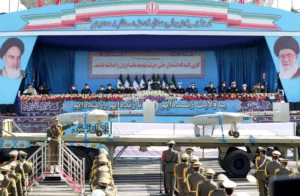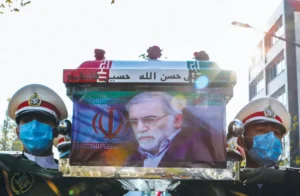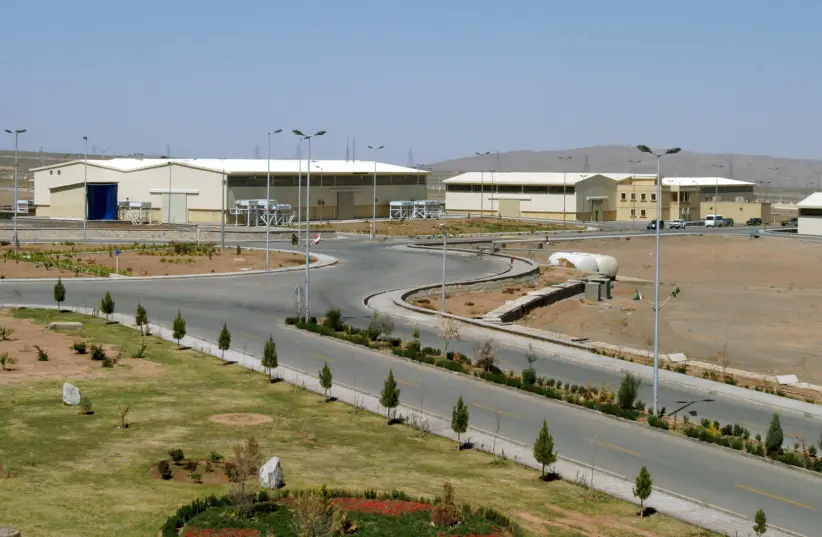“With this quantity, an enrichment level of 60% suffices to create a relatively compact nuclear explosive,” Albright said.

Iran could have four “crude” nuclear bombs within three months if it decides to cross the nuclear threshold, the Institute for Science and International Security announced on Wednesday.
This would not be the same as having full-fledged nuclear weapons, which could be delivered on a ballistic missile (that could take another six months to two years of development).
But it is a more serious threat than the enriched uranium that Israel and others have faced from the Islamic Republic.
Timeline for a nuclear Iran
A position paper by the think tank’s David Albright and Sarah Burkhard said that for one “crude” bomb, Iran’s breakout timeline is essentially already zero.

This is because “it has enough 60% enriched uranium or highly enriched uranium (HEU) to be assured it could fashion a nuclear explosive… within a few weeks, with only a few of its advanced centrifuge cascades.”
The report then said, “In parallel, within a month, it could produce enough weapons-grade uranium for a second nuclear explosive from its existing stock of near 20% low enriched uranium. Within six weeks after a breakout, it could accumulate enough for a third nuclear weapon, using its remaining near 20% enriched uranium and some of its 4.5% enriched uranium.”
Finally, within “2.75 months (11 weeks) after starting a breakout, it could have a fourth quantity by further enriching 4.5% enriched uranium up to 90%. At six months, it could have produced a fifth quantity by further enriching both 4.5% enriched uranium and natural uranium. The accumulation for a sixth would take several months longer.”
Albright’s supposition that a crude nuclear bomb can be made using 60% enriched uranium is somewhat theoretical, because discussion about nuclear weapons developed from uranium in recent decades has focused on the 90% enrichment level.
That level has thus far been Israel’s focus; the US and other parties seek to prevent the Islamic Republic from developing such a nuclear device.
Even if Tehran reaches the 90% level, Israeli intelligence and nuclear experts have said that Iran would need another six months to two years to perfect methods for detonation, warhead miniaturization, missile reentry, and other issues, before being able to deliver such a weapon.
Still, another recent report by Albright and Burkhard said, “As soon as mid-to-late April, Iran is expected to reach a new, dangerous, destabilizing threshold, having enough highly enriched uranium (HEU) to fashion a nuclear explosive, about 40-42 kilograms of 60% enriched uranium (uranium mass). With this quantity, an enrichment level of 60% suffices to create a relatively compact nuclear explosive; further enrichment to 80 or 90% is not needed.’
“According to the International Atomic Energy Agency, 41.7 kg. of 60%-enriched uranium is a significant quantity, which the IAEA defines as the ‘approximate amount of nuclear material from which the possibility of manufacturing a nuclear explosive cannot be excluded,’” wrote Albright.
“A common fallacy is that Iran would require 90% HEU, more commonly called weapons-grade uranium, to build nuclear explosives,” he said.
“Although Iran’s nuclear weapons designs have focused on 90% HEU and likely prefer that enrichment, modifying them for 60% HEU would be straightforward and well within Iran’s capabilities.”
David Albright
He added that, “historically, the term ‘highly enriched uranium’ was developed in the nuclear weapon states to distinguish between enriched uranium able to fuel a practical nuclear weapon versus enriched uranium, labeled low enriched uranium, unable to do so. Their cutoff is at 20% enriched uranium.”
In fact, Albright explained to The Jerusalem Post that lower levels of enriched uranium were used in nuclear weapons designs by the US in the 1940s as well as by South Africa.
Little Boy, the nuclear bomb dropped on Hiroshima, mixed the highest level of enriched uranium with some uranium enriched to as low as 50%.
Albright said that states have focused on the 90% level because its more compact size makes it usable on missiles, while lower enriched nuclear weapons are larger and much harder to deliver.
Also, he said that 60%-enriched devices require a greater amount of high explosives to initiate the detonation process.
“At the least, a device made from 60% HEU would be suitable for underground nuclear testing or delivery by a crude delivery system,” he said.
Albright also released newly translated Iranian documents relating to their efforts to conceal their nuclear program from the IAEA nuclear inspectors.
Mohsen Fakhrizadeh’s involvement
As part of the new documents, which Israel has confirmed came from the Mossad’s 2018 raid on the Islamic Republic’s secret nuclear archives, Albright said there is new evidence of the involvement of assassinated Iran nuclear chief Mohsen Fakhrizadeh in the cover-up.

In one document from 2004, Fakhrizadeh wrote to the “Honorable Deputy Minister (of Defense) Sardar,” in office from 2003-2005. [Translator comment: The second note, written in black and signed as “Hosseini T,” suggests the Sardar (general) might have been the IRGC Brigadier General Seyed Ali Hosseini Tash.]
Fakhrizadeh continued, “With respect, attached [is the] presenting [of] the last summary regarding Kimiya Maadan Company (a company whose nuclear activities Iran wanted to hide and transfer). A copy of the document, including the appendices, was provided to the Protection (Organization) to discuss and comment on in their internal committee.”
Albright explains that the Protection Organization likely refers “to either the Intelligence Protection Organization of the Islamic Revolutionary Guard Corps (IRGC) or the Intelligence Protection Organization of the Ministry of Defense and Armed Forces Logistics.”
“Please provide your corrections and guidance to redact the final version if needed,” finishes Fakhrizadeh.
Responding, Iran Deputy Defense Minister Tash wrote, “Mr. Fakhrizadeh: This is one of the critical areas that sooner or later, they (the agency) will question us about. Therefore, we must have a comprehensive scheme for it. Conduct a meeting with Mr. Barzegar and, if necessary, with Sardar (IRGC General) Kalantari to finalize the scheme and recommendations so that later, it is presented and finalized in the policy meeting (with Sardar Vahidi and Sardar Sadegh).”
Albright explains that Tash is referring to “IRGC Brigadier general Ahmad Vahidi, who between 2003–2005 was the Vice Minister of Defense for Planning and International Affairs… Whenever your work is ready, notify us to schedule the meeting. Of course, you must rush.”

